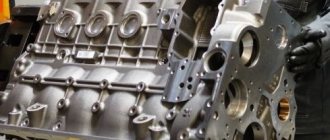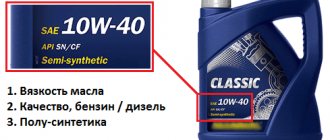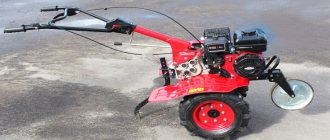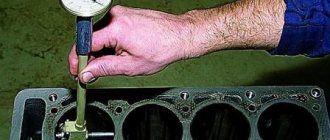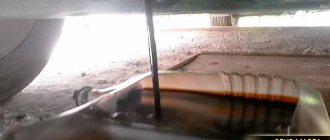For the Lifan Solano model, the following motor oils are used: 10W-40 and 5W-40, depending on the degree of viscosity - synthetic or semi-synthetic. The car manufacturer recommends changing the oil every 10,000 km, or once a year, whichever comes first. The following motor oils are suitable for this car: Castrol, Mobil 1, Motul and many others.
–>
How is the oil changed?
The car manufacturer recommends changing the oil every 10,000 km, or once a year, whichever comes first.
It is necessary to change the oil at the required intervals, according to the special operating instructions for the vehicle. The engine oil is poured into the engine, the type of which is indicated in the instructions, according to the manual. But what should you do if you need to add oil on the road, but you don’t have exact information about what kind of oil is currently in the engine, or if the exact same type of oil is not available for sale? Is it possible to mix motor oils (?) - read about it here.
In order for the Lifan Solano sedan to work without failures and malfunctions, you need to select an engine oil for it that is suitable specifically for this model, and you will also need to install an oil filter and an o-ring under the drain plug.
To start filling, you need to find the place where the oil filter is located and the place where the crankcase drain plug is located. After general preparation, all that remains is to drive the car onto the overpass, and this can be considered preparation for the main work.
First, the car engine must be turned off.
First, we shut off the engine and put the car in gear and the handbrake. Warm oil drains easier. We remove the cap from the neck of the cylinder head, then remove the pan drain plug, but first, you need to place a container underneath so that the oil that has already been used is drained. The main thing is not to get burned, since the oil is quite hot.
We wipe the opening and plug using a clean rag after draining all the oil, then tighten the plug and replace the old sealing ring.
We remove the used filter, clean its seat, then lubricate the threads of the new spare part and the sealing ring with oil, and screw the filter in completely.
After all this is done, simply fill in the engine oil before removing the dipstick from the neck opening. First, pour in 1/2 of the oil that needs to be poured, waiting for it to drain. After that, take the dipstick and measure how much oil is left and add the rest.
We start the car engine, check it for serviceability, to be sure that everything went as it should, when turning off the engine, we check whether the drain and filter plugs have leaked, and also carry out a control measurement using a dipstick.
What kind of oil is in the first fill from the factory?
For more information about the 1.6-liter engine, read the material: characteristics of the Lifan Solano engine. The manufacturer recommends using XADO 75w90 oil; this is a universal, modern synthetic oil that will surprise you with its durability and has a high viscosity index, which ensures trouble-free operation of transmissions at temperatures (-40°C).
What oil do car owners recommend?
According to the recommendations of car owners, it is recommended to fill in Mannol oil, when used, oil consumption is barely noticeable. The main thing is to choose a viscosity class of SAE 0W40 and an API quality of at least SM, in severe frosts.
–>
Lifan Solano car engine with a volume of 1.6 liters
What is noteworthy is that Lifan Solano has no problems with the engine. The inline four-cylinder 16 valve engine of the car is based on the licensed agent Toyota 4A - EF , and this, as all car enthusiasts know, is the standard of quality, simplicity and reliability. Read more about the 1.6-liter engine in the following materials:
Replacing the rear mount of a Lifan Solano engine
Brought to you by everyone! I decided to unsubscribe how I did it. For work we will need: 1. Head 18 (PS You need to take a long head!) 2. Key to 183. Jack4. Key for 155. Head for 136. VD40 Here is number BAC1001210 Cost 450 RUR
And so let's begin!1. Remove protection2. Let's jack up gearbox 3. Using a 18mm head, unscrew the farthest bolts of the cushion from the subframe.4. We unscrew the closest bolts of the cushion from the subframe with a 13mm head, placing a 15mm wrench on top so that it does not turn!5. Let's jack up gearbox 6 to the maximum. In order to unscrew the cushion from the engine, you need to support it with a 18 key, and in the opened space you can simply unscrew the 15 bolt on the other side (or I don’t remember 13)7. After struggling to remove the pillow.8. Use the same method to push it back!9. With a miracle and prayers, zinc the pillow10. Lower gearbox11. Screw12. Thank all the gods that you did this! and promise that you won’t do it again! throw away your old pillow.
PS All operations are carried out under the car and you no longer need to walk around it; nothing can be unscrewed from any side! PS2 If there are additions, please add or edit this post!
It’s completely possible to do it alone. The main thing is to have a key for 13,15,18 and a long head for 18. Naturally, a jack and all sorts of lever tubes
No need to change your pillow for another piece of shit. It is necessary to press in a new silent seal from Metsubishi. If you are interested, write
Hello, do you have a front airbag on your car?
There are 3 airbags on the car. Rear, right and left under the battery
In the end, what is the effect? Are there less vibrations at idle?
you probably don’t dig deep. My friend Granta has one. So he doesn’t look into it at all and doesn’t listen. He sat down and drove off. And I sat down and immediately found a bunch of stocks in the chassis. So I’ll dig up a lot of things for you too
Then I dont know. Maybe this is the specificity of the machine? My mileage is 61,000 km and it doesn’t give me any problems.
From the first days I practically welded a long corrugation under the crankcase and replaced the original small corrugation with a longer one, to no avail, it had no effect on the vibration at idle.
I believe so. I planned to entrust the corrugation to the same thing. But then later I lost the desire to invest in a car. Enough is enough
Tony four fingers, hello Tony, regarding the vibration, if you are curious, go to the Altai Village channel and look at the modifications of the Lifan Solano , you can see in the video that I installed an auxiliary support and changed the corrugation with installation under the engine , and believe me, I can’t be happier with the ride - the engine does not “lay down” while driving and forgot about the vibration, but that’s up to you to judge
Replacing Silent Blocks Polyurethane Polyurethane Bushes
How to Change the Rear Motor Mount on a Geely Emgrand Ec7 Jl4G15
Removing the Right Drive Lifan 620 Solano
Lacetti twitches Part 4 Lower Motor Mount Hot Summer
Installation of Seat Heating Via 4X Contact Relay
WHERE IS THE ENGINE NUMBER LIFAN SOLANO / Lifan Solano
Replacing the Silent Block of the Lower Motor Support
Difficulties of Lifan Solano 2 Solano 2 On a Range of 8000 Thousand Km Review from the Owner
One-Person Brake System Repair Lifan Solano
Lifan Solano Front Pillar Removed Installed
Lifan Solano Changing the Stabilizer Struts and Bushings
Clutch Lifan Solano Lifan Slano Addition
Masha and the Bear You Dance and I Dance in Japanese
Vogel Among Old Houses Official Audio
Replacing the Rear Cushion of a Lifan Solano in One Person
Katya Adushkina Dream 5 Snow Party VTB Arena
It Is Written Prequel Of The Bible The Selfishness Paradigm
Scarica Suonerie Ta Ra Ra Ra Mp3 Gratis Suonerietelefono Com
Sally Bundock Bbc World News Presenter Recently Added To The Power Part Time List
Yakinlah Allah Pasti Mengubah Nasibmu Tidak Ada Yang Tidak Mungkin Selama Engkau Percaya
Spacious Elegant Ships Holland America Line
1 Hour And in my yard everyone is playing Brawl Stars
Engine technical parameters
- The combustion chamber is wedge-shaped.
- Compression pressure is more than 1000 kPa.
- The pressure difference in the cylinders is less than 100 kPa.
- Lubricant volume – 4 l.
- Compression ratio – 9.5.
- The piston stroke is 7.7 cm.
- The volume of all cylinders is 1587 ml.
- The internal radius of the cylinder is 40.6 mm.
- Fuel type – unleaded 93.
- Oil pressure at idle speed is 100–300 kPa.
- Oil pressure at maximum speed is 350–500 kPa.
- Oil pressure at 3 thousand rpm – 280–450 kPa.
- Oil – category SG.
- Rotate the shaft clockwise.
- The coolant is water (distillate, bidistillate).
- The cooling system is forced.
- The ignition order is 1-3-4-2.
- Start - from electrical equipment.
- Lubrication system - spray under pressure.
- The opening temperature of the thermostat valve is 83 * C (full opening - 95 * C).
- Maximum speed – 6 thousand rpm.
- Maximum power – 78 kW.
- Engine weight with/without transmission parts – 130.5/104 kg.
- XX speed – 750–850 rpm.
- Specific fuel consumption is less than 270 g/(kW h).
Characteristics of motor electrical equipment
- The rated voltage of the generator is 12 V.
- Starter power – 1.3 kW.
- Regulator voltage is 13.2–14.8 Ohms.
- The maximum resistance of high voltage wiring is 25 Ohms.
- The gap between the electrodes is 0.8 mm.
- The resistance of the primary (secondary) winding of the ignition coil is 0.36–0.55 Ohm (9.84 kOhm).
- The battery is lead-acid.
- The recommended spark plug marking is K7RTC.
A powerful Toyota engine of 106 horsepower allows the driver of a 1200-kilogram Lifan Solano to accelerate the car to 100 kilometers in 15.5 seconds.
In general, Lifan Solano leaves a pleasant and very solid impression on the driver who has driven it at least once. And don’t forget that before entering the domestic market, this car was tested and won many fans “at home.”
–>
Author: Valery Motorin Section: LIFAN
Lifan Solano (aka Lifan 620) appeared in Russia in 2010. Cars are assembled in Cherkessk. The design of the Solano contains the roots of the 2001 Toyota Corolla in the E120 body. The body shape also resembles the Japanese bestseller. But is Lifan Solano ready to repeat the success of the once popular Corolla, how reliable is it?
Replacing the timing belt Lifan Solano
Many car enthusiasts pay attention to their car, promptly repair and replace parts of the car’s internal equipment. Rules and terms for carrying out a technical inspection of a car have been developed specifically for convenience. However, some details require a more thorough approach when conducting a comprehensive diagnosis.
One of these elements is the timing belt, which ensures smooth operation of the engine due to the synchronous operation of the crankshaft and camshaft. If the problem is not identified and corrected in a timely manner, problems with engine operation may occur, which is why it is so important to know the rules for installing a new timing belt. Today in the article we will look at how to replace the Lifan Solano timing belt. If you also want to learn the repair algorithm and learn how to make repairs yourself, we recommend reading the information below.
Engine
The Chinese sedan is offered with one engine with a displacement of 1.6 liters and 106 hp, which is a licensed copy of the Toyota 4A-FE with a modified intake manifold. The timing drive on this power unit is belt driven, requiring replacement every 60 thousand km. The engine itself is very reliable and economical, but after the intervention of Chinese engineers, some features appeared. So, when driving with a still cold engine, the car begins to twitch. Many have encountered inexplicably increased engine vibration at idle speed. In search of a solution to the problem, owners modify the exhaust system by inserting an elastic corrugation. Others manage to overcome vibration by adjusting the engine mount. In the rpm range of 1700 - 2500, the throttle assembly often begins to “whistle”.
The idle speed control may fail even after a mileage of 15–20 thousand km (600 rubles). In winter, the gas pedal may jam due to freezing of the control cable in the “protective jacket”, where moisture gets in and condensation accumulates. For prevention before frost, it is necessary to treat the assembly with silicone grease.
Due to flimsy clamps, the coolant pipes connecting the engine to the radiator often leak. It is better to replace the original clamps. With a mileage of more than 30 - 40 thousand km, there were cases of radiator leakage (5 - 7 thousand rubles).
With a mileage of more than 10 - 25 thousand km, the fuel pump (1-2 thousand rubles) and the fuel level sensor may fail due to loss of contact between the track and the clamp.
Main characteristics of the 1.6 engine on Lifan Solano
Every consumer who wishes to purchase a Lifan Solano car should first of all familiarize themselves with the assessments of more or less experienced drivers who have had “close acquaintance” with this car, as well as find out all the most important characteristics of this vehicle.
Lifan Solano car engine with a volume of 1.6 liters
Even the most inexperienced person knows that road safety is the main priority of any driver - fortunately, this car fully meets all the necessary requirements for ensuring the protection of both the driver and his passengers. Another decisive point when choosing a car is the engine parameters - displacement, effective power, etc.
Transmission
There is only one gearbox - 5-speed manual. There are many complaints from owners about the clutch, which begins to slip already after a mileage of 20–40 thousand km. After opening it, it is discovered that the disk is not worn out, but after replacing it, no such problems arise. A new clutch kit will cost 4-6 thousand rubles, and replacing it will require about 3 thousand rubles.
Many also note the appearance of a hum in the box when releasing the gas in 2nd and 3rd gears with a mileage of more than 20 thousand km. After replacing the input shaft bearing, the noise goes away. In winter, due to the jamming of the box breather valve, the seals can be squeezed out. The speed sensor is a real consumable, failing after 10 - 20 thousand km (1000 rubles).
Negative reviews are also poured into the suspension, which begins to creak after a mileage of more than 20 thousand km, more often in winter. In addition, with the advent of frost, knocking noises appear, which can often be eliminated by tightening the suspension elements. Shock absorbers can leak after a mileage of more than 20 - 30 thousand km, by which time the anti-roll bar struts begin to knock.
Problems with ABS are also quite common. The reason is the chips that are not properly clicked, the poor quality of the brake fluid poured during assembly, and less often, the ABS sensors themselves. Original brake pads are very hard, which leads to rapid wear of the brake disc and excessively early activation of ABS in critical situations.
In winter, the power steering pump often begins to “growl”, the reason is in the fluid, replacing which solves the problem. Steering rods begin to tap already after a mileage of 10 - 20 thousand km (1-2 thousand rubles).
Body and interior
The Solano body has a relatively thin layer of paintwork; chips appear quite quickly. Bare metal is not prone to blooming, but if you do not take any action to eliminate the chip, it will soon become covered with rust. The quality of fit of the mounted body elements, mainly the doors and trunk lid, also raises complaints. Uneven gaps are often noticeable; in addition, the doors do not close well. Which in turn leads to the appearance of dents on the thin metal of the door when you try to slam it again, applying force not to the door handle.
The fuel filler cap often falls apart when it is screwed on. The plastic hood stop holders break just as easily.
Due to poor-quality window sealing and poor sealant treatment of the welded seams of the roof with the side of the body or the rear fender with a shelf under the glass, water often gets into the interior and luggage compartment.
Creaks in the Lifan's cabin appear in the rear door panels, in the rear pillars, in the area of the instrument panel, radio and rear seat back lock. Over time, the decorative knob of the gear shift lever begins to rotate freely and the leatherette covering the free space between the central tunnel and the knob breaks.
Other problems and malfunctions
The heated seats fail within the first year of operation. The reason is the thin filaments of the heating element, located on the sides of the seat, which break when getting into the car.
The air conditioner stops cooling the air due to the tube breaking at the base. The reason is the close location to the radiator and rubbing against its corner. Later, the defect was eliminated and the tube began to be installed correctly in August 2011.
On many Solanos, the radio and interior heater are not fully attached from the factory. In this case, the radio begins to creak, and a draft appears in the legs due to the heater.
Electrical problems are most often caused by the BCM (Body Control Module). The new unit will cost 5 thousand rubles. Its “glitches” and failures lead to incorrect operation of the direction indicators and problems with the central locking. Voltage instability at the output of the unit leads to slightly noticeable flickering of the backlight of the instrument panel and radio at night. In wet weather and winter, parking radar sensors often fail, but come to life with the arrival of warmth and sun.
Engine Lifan Solano 2
Lifan Solano has a fairly powerful engine for this class of car. The electronic ignition timing control system constantly adjusts fuel ignition, which allows the engine to operate at the most economical modes and reduce emissions of toxic substances into the atmosphere. The engine has a unique DIS CAP system, individual ignition coils for each spark plug, it allows for guaranteed ignition of the fuel-air mixture under changing loads and engine speeds.
The cylinder block is made of cast iron alloy, so it has become more resistant to overheating in various temperatures and weather conditions. The engine operates at low and high temperatures.
Features of Lifan Solano ll
- Stylish and modern body design!
- Spacious and roomy trunk;
- The rear seatbacks can be folded down;
- Spacious and comfortable interior;
- On the electronic scale: indicators of coolant temperature, fuel level and odometer;
- The seats were designed to accommodate the different shapes of the human body;
- The back of the chair is adjustable;
- The interior features cup holders and a glove box;
- “Children’s” door lock;
- Three-point seat belts with height adjustment;
- Alarm for unfastened seat belts, open doors and trunk;
- Frontal airbags;
- Safety steering column;
- Wide rear view mirrors;
- ABS Anti-lock braking system;
- EBD Electronic Brake Force Distribution System;
- Each wheel has disc brakes;
- Parking sensors are installed on the rear of the body;
- Front independent MacPherson strut suspension;
- Rear semi-independent, wishbone, spring suspension with hydraulic shock absorbers;
- Suspensions reduce noise levels while driving and ensure good tire grip on the road surface.
Electronic control system
The Lifan Solano engine has a modern electronic control system consisting of three main elements. These include the following control system components:
- One of the key electronic components in this car are sensors that convert incoming non-electrical signals into electrical ones, which will be recognized by the built-in electronic control system. The system includes intake pressure and temperature sensors, a throttle sensor indicating the position of the gas pedal, and a sensor indicating the temperature of the coolant in the thermostat. A special oxygen sensor monitors the content of this gas in the exhaust mixture. The system also includes a knock and crankshaft position sensor, which is used to recognize the position of each cylinder in the engine.
- The second link, which performs the main task of the entire system, is the electronic control unit. Here all incoming signals are processed, evaluated, and an order is issued to the executive level.
- Actuators that execute commands received from the electronic control unit. This group includes the fuel pump and injectors, idle air control, and ignition coils.

